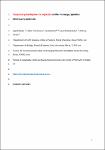Impacts of polyethylene microplastics on the microalga, Spirulina (Arthrospira platensis)
| dc.contributor.author | Abbasi, S | |
| dc.contributor.author | Amiranipour, S | |
| dc.contributor.author | Karimi, J | |
| dc.contributor.author | Mohsenzadeh, S | |
| dc.contributor.author | Turner, Andrew | |
| dc.date.accessioned | 2023-08-07T08:39:07Z | |
| dc.date.available | 2023-08-07T08:39:07Z | |
| dc.date.issued | 2023-06 | |
| dc.identifier.issn | 0269-7491 | |
| dc.identifier.issn | 1873-6424 | |
| dc.identifier.other | 121611 | |
| dc.identifier.uri | https://pearl.plymouth.ac.uk/handle/10026.1/21164 | |
| dc.description.abstract |
Microalgae play a critical role in the food web and biogeochemical cycling and produce compounds that are commercially exploited. However, their reactions and responses to microplastic contamination are not well understood. In this study, the widely distributed and commercially important cyanobacterium, Spirulina (Arthrospira platensis), was exposed to different concentrations (1–100 mg L−1) of low-density polyethylene microplastics (<5 μm) over a 20-d period. Various end-points were combined with different microscopic techniques in order to examine physiological and biochemical effects and interactions between the plastic and microalga. Growth rate and photosynthetic activity decreased with increasing microplastic concentration, and a maximum inhibition ratio of about 9% was calculated from optical density measurements. Plastic concentrations above 10 mg L−1 resulted in oxidative stress and the intracellular production of proline. Fragmentation and swelling of trichomes and attachment of microplastics was observed in the exposures, and microplastics appeared to adhere or aggregate around fragmented or fragmenting regions. The latter effect may indicate trichome weakening by microplastics or their concentration around cytosolic debris; nevertheless, it provides a potential mechanism for internalisation of small particles. Although unrealistically high concentrations of well-defined microplastics have been employed, relatively small disruptions at the population level incurred by lower concentrations could have more serious implications for ecosystem services and functioning. | |
| dc.format.extent | 121611-121611 | |
| dc.format.medium | Print-Electronic | |
| dc.language | en | |
| dc.publisher | Elsevier BV | |
| dc.subject | Cyanobacteria | |
| dc.subject | Growth inhibition | |
| dc.subject | Photosynthesis | |
| dc.subject | Nanoplastics | |
| dc.subject | Fragmentation | |
| dc.subject | Ecosystem services | |
| dc.title | Impacts of polyethylene microplastics on the microalga, Spirulina (Arthrospira platensis) | |
| dc.type | journal-article | |
| dc.type | Journal Article | |
| plymouth.author-url | https://www.webofscience.com/api/gateway?GWVersion=2&SrcApp=PARTNER_APP&SrcAuth=LinksAMR&KeyUT=WOS:000983138600001&DestLinkType=FullRecord&DestApp=ALL_WOS&UsrCustomerID=11bb513d99f797142bcfeffcc58ea008 | |
| plymouth.volume | 327 | |
| plymouth.publication-status | Published | |
| plymouth.journal | Environmental Pollution | |
| dc.identifier.doi | 10.1016/j.envpol.2023.121611 | |
| plymouth.organisational-group | |Plymouth | |
| plymouth.organisational-group | |Plymouth|Research Groups | |
| plymouth.organisational-group | |Plymouth|Faculty of Science and Engineering | |
| plymouth.organisational-group | |Plymouth|Faculty of Science and Engineering|School of Geography, Earth and Environmental Sciences | |
| plymouth.organisational-group | |Plymouth|Research Groups|Marine Institute | |
| plymouth.organisational-group | |Plymouth|REF 2021 Researchers by UoA | |
| plymouth.organisational-group | |Plymouth|Users by role | |
| plymouth.organisational-group | |Plymouth|Users by role|Academics | |
| plymouth.organisational-group | |Plymouth|Research Groups|BEACh | |
| plymouth.organisational-group | |Plymouth|REF 2021 Researchers by UoA|UoA07 Earth Systems and Environmental Sciences | |
| dc.publisher.place | England | |
| dcterms.dateAccepted | 2023-04-08 | |
| dc.date.updated | 2023-08-07T08:39:06Z | |
| dc.rights.embargodate | 2024-4-7 | |
| dc.identifier.eissn | 1873-6424 | |
| dc.rights.embargoperiod | forever | |
| rioxxterms.versionofrecord | 10.1016/j.envpol.2023.121611 |


